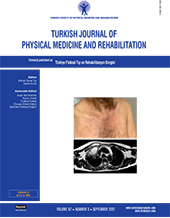Alexithymia in ankylosing spondylitis
2 Department of Physical Medicine and Rehabilitation, Istanbul Medeniyet University Faculty of Medicine, Istanbul, Turkey DOI : 10.5606/tftrd.2021.6415 Objectives: This study aims to determine the effect of ankylosing spondylitis (AS) on alexithymia.
Patients and methods: In this study, a total of 55 AS patients (30 males, 25 females; mean age: 40±8 years; range, 21 to 57 years) who were under follow-up and 55 age- and sex-matched healthy volunteers (31 males, 24 females; mean age: 38.9±8.5 years; range, 21 to 53 years) were included between March 2016 and August 2016. Toronto Alexithymia Scale (TAS), and Beck Depression Inventory (BDI) were performed to assess both patient and control groups. The Bath Ankylosing Spondylitis Disease Activity Index (BASDAI), Bath Ankylosing Spondylitis Functional Index (BASFI), Bath Ankylosing Spondylitis Metrology Index (BASMI), and Ankylosing Spondylitis Quality of Life (ASQoL) were performed to assess AS patients.
Results: The mean diagnosis time in the patient group was 5.18±4.32 (range, 1 to 18) years. Compared to the control group, depression scores were higher in the patient group and the alexithymic characteristics were significantly higher in the patient group (p<0.05). There was a positive correlation between complaint duration and BASMI, BASFI, and ASQoL scores (p<0.01). In our study, alexithymia rate was significantly higher in women (p<0.05).
Conclusion: As in all inflammatory chronic diseases, depression and anxiety are commonly seen in AS patients. Alexithymia of these patients should be considered carefully.
Keywords : Alexithymia, Ankylosing Spondylitis Quality of Life, ankylosing spondylitis, Bath Ankylosing Spondylitis Disease Activity Index, Bath Ankylosing Spondylitis Functional Index, Bath Ankylosing Spondylitis Metrology Index

















